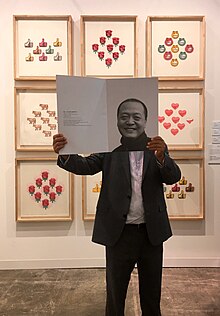Nan Qi (Nan Xi 南溪) | |
|---|---|
 Nan Qi, 2016 | |
| Born | July 25, 1960 Yongkang, Zhejiang, China |
| Nationality | Chinese |
| Education | People's Liberation Army Academy of Art |
| Known for | Painting, drawing |
| Movement | Contemporary Art |
Nan Qi or Nan Xi (Chinese: 南溪; born July 25, 1960) is a Chinese artist based in Beijing. He is best known for his "halo dot" paintings which combine traditional Chinese ink painting methodology with modern technology, creating a "Ben-Day" dot effect.
Nan Qi was born to a peasant family in Yongkang, Zhejiang, China in 1960.[1] Having spent his childhood during the upheaval of the Cultural Revolution, Nan experienced extreme poverty as a child and joined the People’s Liberation Army at the age of 18. He graduated from the People’s Liberation Army Academy of Art in 1986, having specialised in traditional Chinese landscape ink painting.[1]
Nan is a contemporary Chinese ink painter depicting a variety of themes, ranging from the human form to landscapes and abstract concentric ink dots, using Chinese in and xuan rice paper. During his training as a Chinese ink painter, Nan specialised in classical landscapes inspired by Tang, Song, Yuan, Ming, and Qing dynasty artists.[2] Early experimentation with different brush strokes and techniques, varying the dilution of ink and wash, resulted in the distinctive ink “dabs” produced in his early works. During the mid-to-late 1990s, Nan began designing and printing the catalogues for his own exhibitions, and was inspired by the dot matrices used in printing. This gave rise to a progression from ink “dabs” to more and more dot-like brush strokes, culminating in his development of his signature “halo dot” brush stroke in 2004. At this point, the themes and content of Nan’s work were becoming solidly contemporary and modern, moving away from landscapes. Over the next ten years, Nan developed a completely unique repertoire of brush strokes and ink painting techniques, including the “halo dot”, the “Nan Qi Way” for controlling ink flow into highly absorbent rice paper, and the “3D ink” technique, which allows him to create three-dimensional optical illusions by hand.[1][2]
Nan has two daughters with his former wife Susie, an English lecturer. He currently lives and works in Song Zhuang, an artist's community in Beijing, China.[1]
Nan's classical training in traditional Chinese ink painting created the discipline and grounding for his later innovation in pushing the boundaries of his media: ink and xuan rice paper. His paintings portray women, men, animals, buildings, landscapes, banknotes, and abstract giant "halo dots" in a contemporary and straightforward fashion whilst remaining true to the millennia-long artistic tradition he draws on. The subject matter of his paintings reflects Nan’s desire to hold up a mirror to the shifting political and socio-economic climate in China, whilst playfully drawing his audience into the "halo dots" that make up these images.[1]
Nan’s early work emphasises his strong connection to traditional Chinese culture and his fascination with the lyricism of ancient Chinese landscape artists. His mountainous scenes from the late 1980s and early 1990s feature strong, inky brushwork broken up by ink “dabs” which showcase the rugged textures of these rocky landscapes. Small figures, mules, and remote hamlets appear regularly in these early works, reminiscent of his rural upbringing.[1][2]
His marriage to an English woman in 1989, and their honeymoon at Beidaihe beach, began Nan's forays into producing mesmerising seascapes and pursuing a more contemporary aesthetic. These works retained the strong brushwork of his mountain landscapes whilst moving towards realism in his representation of waves and ocean spray. A year after the birth of his first daughter, Nan holidayed in France and the United Kingdom and was exposed to Surrealism, Modernism, Cubism, and other 20th-Century artistic movements for the first time. This proved to be a career-defining vacation, as his mountain landscapes took on a futuristic, Cubist atmosphere which enhanced the eeriness of lonely mountains in the mist.[3]
In the late 1990s, dissatisfied with the quality and cost-effectiveness of printing companies, Nan began designing and printing his own exhibition catalogues in Shenzhen, China. Examining proofs at the printing press and learning how image printing works, Nan developed an interest in the minute dot matrices that make up every print image.[3] This led to a five-year period of experimentation with ink "dabs", which eventually evolved into Nan's signature "halo dot" in 2004. His process of painting single ink dots and carefully controlling the absorption rate of ink into the rice paper creates a concentric layering effect. Nan’s large-scale abstract “halo dot” paintings are reminiscent of Rorschach blots, bringing to mind flowers, vulvas, eggs, or stars. His figurative and landscape dot paintings create a pointillist effect from a distance and, when viewed up-close, reveal a web of almost-touching "halo dots" which are completely unique from each other.[4]
Nan developed his 3D Ink art technique after unearthing a forgotten copy of a 1970s book of optical illusions in his library at home. Combining modern digital technology and traditional ink painting techniques with his "halo dots", Nan worked for three years in a process of trial and error to produce apparently abstract or corrupted images. By alternately focusing and unfocusing their eyes, viewers are able to bring three-dimensional optical illusions into view, apparently floating above the paintings. These illusions appear and disappear in the blink of an eye, and often viewers are only able to obtain a fleeting glimpse of the image. Nan's 3D Ink Art sparked some controversy among China's ink painting critics when debuted, setting off a debate between Li Xieting and Liu Xiaochun about the nature of contemporary ink painting in China.[5]